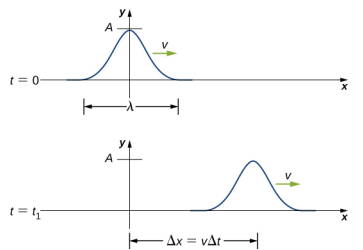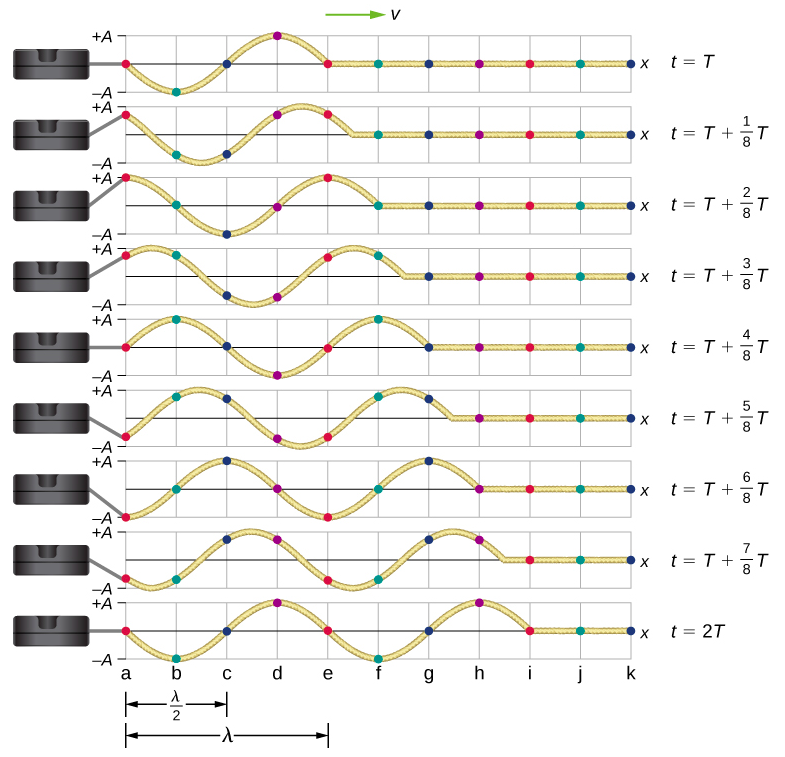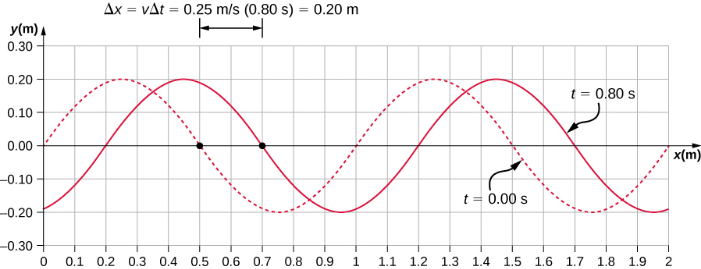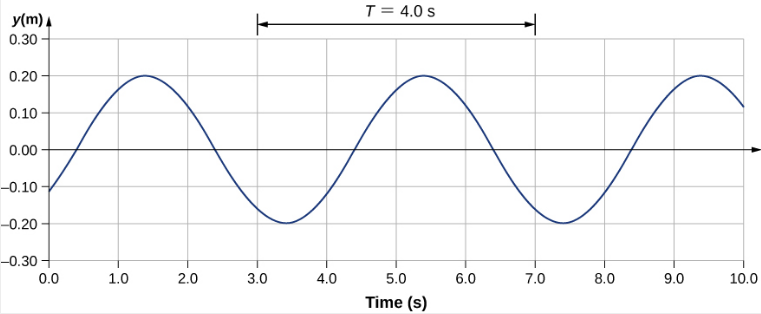how to find the amplitude of a wave
16.3: Mathematics of Waves
- Page ID
- 4070
- Model a moving ridge, moving with a abiding wave velocity, with a mathematical expression
- Calculate the velocity and acceleration of the medium
- Show how the velocity of the medium differs from the wave velocity (propagation velocity)
In the previous section, nosotros described periodic waves by their characteristics of wavelength, menses, amplitude, and wave speed of the moving ridge. Waves tin besides be described by the motion of the particles of the medium through which the waves move. The position of particles of the medium can be mathematically modeled as wave function due south, which can be used to find the position, velocity, and dispatch of the particles of the medium of the moving ridge at any time.
Pulses
A pulse can be described as moving ridge consisting of a single disturbance that moves through the medium with a constant amplitude. The pulse moves as a pattern that maintains its shape every bit it propagates with a constant wave speed. Because the moving ridge speed is constant, the altitude the pulse moves in a time Δt is equal to Δx = vΔt (Figure \(\PageIndex{1}\)).

Modeling a One-Dimensional Sinusoidal Wave Using a Moving ridge Function
Consider a cord kept at a constant tension \(F_T\) where one end is fixed and the free end is oscillated between \(y = +A\) and \(y = −A\) by a mechanical device at a constant frequency. Figure \(\PageIndex{ii}\) shows snapshots of the wave at an interval of an 8th of a menses, beginning later 1 menstruum (\(t = T\)).

Detect that each select point on the string (marked past colored dots) oscillates upwardly and down in elementary harmonic motion, between \(y = +A\) and \(y = −A\), with a menstruum \(T\). The wave on the string is sinusoidal and is translating in the positive x-direction as time progresses.
At this point, it is useful to call back from your study of algebra that if \(f(x)\) is some office, and so \(f(x−d)\) is the aforementioned function translated in the positive ten-direction by a distance \(d\). The function \(f(x+d)\) is the same office translated in the negative 10-direction by a distance \(d\). We want to define a wave role that will give the \(y\)-position of each segment of the cord for every position x along the cord for every time \(t\).
Looking at the beginning snapshot in Figure \(\PageIndex{2}\), the y-position of the string betwixt \(x = 0\) and \(10 = λ\) tin be modeled as a sine office. This wave propagates downwards the cord 1 wavelength in one period, equally seen in the concluding snapshot. The moving ridge therefore moves with a constant wave speed of \(5 = λ/T\).
Call up that a sine part is a function of the angle \(θ\), oscillating between +1 and −1, and repeating every \(2π\) radians (Figure \(\PageIndex{3}\)). However, the y-position of the medium, or the wave office, oscillates between \(+A\) and \(−A\), and repeats every wavelength \(λ\).

To construct our model of the moving ridge using a periodic part, consider the ratio of the angle and the position,
\[\begin{align*} \dfrac{\theta}{x} &=\frac{ii \pi}{\lambda}, \\[4pt] \theta &=\frac{2 \pi}{\lambda} 10. \end{marshal*}\]
Using \(\theta = \frac{two\pi}{\lambda}x\) and multiplying the sine part by the amplitude A, we tin can at present model the y-position of the string as a role of the position x:
\[ y(10)=A \sin \left(\frac{2 \pi}{\lambda} ten\right). \nonumber \]
The wave on the string travels in the positive ten-direction with a constant velocity 5, and moves a distance vt in a time t. The wave function tin now be defined by
\[ y(x, t)=A \sin \left(\frac{2 \pi}{\lambda}(x-five t)\right). \nonumber \]
It is often convenient to rewrite this moving ridge function in a more compact form. Multiplying through by the ratio \(\frac{two\pi}{\lambda}\) leads to the equation
\[ y(x, t)=A \sin \left(\frac{2 \pi}{\lambda} x-\frac{two \pi}{\lambda} 5 t\right). \nonumber \]
The value \(\frac{2\pi}{\lambda}\) is divers as the wave number. The symbol for the wave number is k and has units of inverse meters, m−1:
\[ k \equiv \frac{ii \pi}{\lambda} \label{sixteen.2} \]
Retrieve from Oscillations that the angular frequency is defined equally \(\omega \equiv \frac{two\pi}{T}\). The 2nd term of the wave function becomes
\[\frac{2 \pi}{\lambda} 5 t=\frac{2 \pi}{\lambda}\left(\frac{\lambda}{T}\correct) t=\frac{two \pi}{T} t=\omega t. \nonumber \]
The moving ridge function for a simple harmonic wave on a string reduces to
\[ y(10, t)=A \sin (k x \mp \omega t) \nonumber \]
where A is the amplitude, \(k = \frac{2\pi}{\lambda}\) is the wave number, \(\omega = \frac{2\pi}{T}\) is the angular frequency, the minus sign is for waves moving in the positive x-direction, and the plus sign is for waves moving in the negative ten-direction. The velocity of the moving ridge is equal to
\[ v=\frac{\lambda}{T}=\frac{\lambda}{T}\left(\frac{2 \pi}{2 \pi}\correct)=\frac{\omega}{chiliad} \characterization{16.3} .\]
Recall back to our give-and-take of a mass on a leap, when the position of the mass was modeled every bit
\[ten(t) = A \cos(ωt+ϕ). \nonumber\]
The angle \(ϕ\) is a phase shift, added to permit for the fact that the mass may have initial conditions other than \(ten = +A\) and \(v = 0\). For similar reasons, the initial phase is added to the wave role. The wave part modeling a sinusoidal wave, allowing for an initial phase shift \(ϕ\), is
\[ y(x, t)=A \sin (thou x \mp \omega t+\phi) \label{16.4} \]
The value
\[ (k x \mp \omega t+\phi) \label{xvi.five} \]
is known as the phase of the moving ridge, where \(\phi\) is the initial phase of the wave part. Whether the temporal term \(\omega t\) is negative or positive depends on the direction of the moving ridge. Showtime consider the minus sign for a moving ridge with an initial phase equal to zero (\(\phi\) = 0). The phase of the wave would exist (\(kx = \omega t\)). Consider post-obit a point on a moving ridge, such every bit a crest. A crest will occur when \(\sin(kx - \omega t = ane.00\), that is, when \(k x-\omega t=n \pi+\frac{\pi}{2}\), for whatsoever integral value of n. For instance, ane particular crest occurs at \(grand x-\omega t=\frac{\pi}{2}\). Every bit the moving ridge moves, time increases and ten must as well increase to keep the phase equal to \(\frac{\pi}{2}\). Therefore, the minus sign is for a wave moving in the positive x-direction. Using the plus sign, \(one thousand x+\omega t=\frac{\pi}{2}\). As time increases, x must decrease to keep the stage equal to \(\frac{\pi}{2}\). The plus sign is used for waves moving in the negative x-direction. In summary, \(y(x, t)=A \sin (chiliad x-\omega t+\phi)\) models a moving ridge moving in the positive x-direction and \(y(x, t)=A \sin (thousand 10+\omega t+\phi)\) models a wave moving in the negative x-direction.
Equation \ref{16.4} is known as a elementary harmonic wave function. A wave function is any function such that \(f(x, t)=f(x-v t)\). Later in this chapter, nosotros will see that it is a solution to the linear wave equation. Annotation that \(y(x, t)=A \cos \left(k x+\omega t+\phi^{\prime number}\right)\) works equally well because it corresponds to a unlike phase shift \(\phi^{\prime}=\phi-\frac{\pi}{2}\).
- To discover the amplitude, wavelength, menstruum, and frequency of a sinusoidal wave, write down the moving ridge function in the class \(y(x, t)=A \sin (m x-\omega t+\phi)\).
- The amplitude can be read straight from the equation and is equal to \(A\).
- The period of the wave tin can be derived from the angular frequency \( \left(T=\frac{2 \pi}{\omega}\right)\).
- The frequency can be constitute using \(f = \frac{ane}{T}\)
- The wavelength tin exist found using the moving ridge number \(\left(\lambda=\frac{two \pi}{k}\right)\).
A transverse wave on a taut string is modeled with the wave part
\[ \begin{align*} y(x, t) &=A \sin (k ten-west t) \\[4pt] &= (0.2 \: \mathrm{g}) \sin \left(half-dozen.28 \: \mathrm{yard}^{-1} x-one.57 \: \mathrm{due south}^{-i} t\right) \finish{align*} \]
Find the amplitude, wavelength, period, and speed of the wave.
Strategy
All these characteristics of the wave tin exist found from the constants included in the equation or from simple combinations of these constants.
Solution
1. The aamplitude, wave number, and angular frequency tin be read directly from the wave equation:
\begin{align*}
y(ten, t)=& A \sin (k 10-west t)=0.2 \: \mathrm{1000} \sin \left(6.28 \: \mathrm{m}^{-1} 10-1.57 \: \mathrm{s}^{-1} t\right) \nonumber \\
&\left(A=0.2 \: \mathrm{m} ; chiliad=6.28 \: \mathrm{m}^{-1} ; \omega=i.57 \: \mathrm{due south}^{-1}\correct) \nonumber
\end{marshal*}
2. The wave number can be used to find the wavelength:
\brainstorm{array}{l}
m=\frac{two \pi}{\lambda} \\
\lambda=\frac{2 \pi}{k}=\frac{2 \pi}{half-dozen.28 \: \mathrm{m}^{-1}}=1.0 \: \mathrm{thou}
\end{assortment}
3. The menstruation of the moving ridge can be constitute using the angular frequency:
\brainstorm{array}{l}
\omega=\frac{two \pi}{T} \\
T=\frac{2 \pi}{\omega}=\frac{2 \pi}{1.57 \: \mathrm{s}^{-1}}=4 \: \mathrm{s}
\end{assortment}
iv. The speed of the moving ridge can be found using the wave number and the athwart frequency. The management of the wave tin can be determined by considering the sign of \(k x \mp \omega t\): A negative sign suggests that the wave is moving in the positive x-direction:
\[ |5|=\frac{\omega}{k}=\frac{1.57 \: \mathrm{s}^{-i}}{six.28 \: \mathrm{m}^{-ane}}=0.25 \: \mathrm{m} / \mathrm{south} \nonumber\]
Significance
All of the characteristics of the moving ridge are contained in the moving ridge part. Note that the wave speed is the speed of the wave in the direction parallel to the motion of the wave. Plotting the height of the medium y versus the position x for ii times t = 0.00 southward and t = 0.80 s tin provide a graphical visualization of the wave (Effigy \(\PageIndex{4}\)).

There is a second velocity to the movement. In this example, the wave is transverse, moving horizontally as the medium oscillates upwardly and down perpendicular to the direction of move. The graph in Figure \(\PageIndex{five}\) shows the motion of the medium at signal x = 0.sixty m equally a part of time. Notice that the medium of the moving ridge oscillates upwards and down between y = +0.twenty m and y = −0.20 m every menstruation of 4.0 seconds.

The wave part in a higher place is derived using a sine part. Tin can a cosine function be used instead?
Velocity and Acceleration of the Medium
As seen in Example \(\PageIndex{ii}\), the wave speed is constant and represents the speed of the wave as it propagates through the medium, not the speed of the particles that make upwardly the medium. The particles of the medium oscillate around an equilibrium position as the moving ridge propagates through the medium. In the case of the transverse wave propagating in the x-management, the particles oscillate upward and downwardly in the y-direction, perpendicular to the motion of the moving ridge. The velocity of the particles of the medium is non constant, which ways there is an acceleration. The velocity of the medium, which is perpendicular to the wave velocity in a transverse wave, can exist found by taking the fractional derivative of the position equation with respect to time. The partial derivative is institute by taking the derivative of the function, treating all variables as constants, except for the variable in question. In the example of the partial derivative with respect to time \(t\), the position \(x\) is treated as a constant. Although this may audio strange if y'all haven't seen it earlier, the object of this exercise is to find the transverse velocity at a point, so in this sense, the \(10\)-position is not changing. We have
\[\begin{split} y(x,t) & = A \sin (kx - \omega t + \phi) \\ v_{y} (x,t) & = \frac{\partial y(ten,t)}{\partial t} = \frac{\partial}{\partial t} [A \sin (kx - \omega t + \phi)] \\ & = -A \omega \cos (kx - \omega t + \phi) \\ & = -v_{y\; max} \cos (kx - \omega t + \phi) \ldotp \terminate{split}\]
The magnitude of the maximum velocity of the medium is \(|v_{y\, max}| = A \omega\). This may look familiar from the Oscillations and a mass on a spring.
We tin discover the dispatch of the medium by taking the fractional derivative of the velocity equation with respect to time,
\[\begin{split} a_{y} (x,t) & = \frac{\fractional v_{y}(x,t)}{\partial t} = \frac{\partial}{\partial t} [-A \omega \cos (kx - \omega t + \phi)] \\ & = -A \omega^{2} \sin (kx - \omega t + \phi) \\ & = -a_{y\; max} \sin (kx - \omega t + \phi) \ldotp \cease{split}\]
The magnitude of the maximum acceleration is |ay max| = A\(\omega^{2}\). The particles of the medium, or the mass elements, oscillate in unproblematic harmonic motility for a mechanical wave.
The Linear Wave Equation
We have just determined the velocity of the medium at a position x by taking the fractional derivative, with respect to time, of the position y. For a transverse wave, this velocity is perpendicular to the direction of propagation of the moving ridge. We found the acceleration past taking the partial derivative, with respect to time, of the velocity, which is the second time derivative of the position:
\[a_{y} (x,t) = \frac{\partial^{2} y(10,t)}{\partial t^{2}} = \frac{\fractional^{2}}{\fractional t^{2}} [A \sin(kx - \omega t + \phi)] = -A \omega^{2} \sin (kx - \omega t + \phi) \ldotp\]
At present consider the partial derivatives with respect to the other variable, the position x, property the fourth dimension constant. The get-go derivative is the gradient of the wave at a point ten at a time t,
\[slope = \frac{\fractional y(x,t)}{\partial x} = \frac{\partial}{\fractional x} [A \sin (kx - \omega t + \phi)] = Ak \cos (kx - \omega t + \phi) \ldotp\]
The second partial derivative expresses how the slope of the wave changes with respect to position—in other words, the curvature of the wave, where
\[curvature = \frac{\partial^{ii} y(10,t)}{\partial x^{2}} = \frac{\partial^{2}}{\partial 10^{2}} [A \sin (kx - \omega t + \phi)] = -Ak^{2} \sin (kx - \omega t + \phi) \ldotp\]
The ratio of the acceleration and the curvature leads to a very of import relationship in physics known as the linear wave equation. Taking the ratio and using the equation v = \(\frac{\omega}{grand}\) yields the linear wave equation (also known simply as the wave equation or the equation of a vibrating string),
\[\brainstorm{split} \frac{\frac{\partial^{ii} y(x,t)}{\fractional t^{2}}}{\frac{\fractional^{two} y(x,t)}{\partial x^{2}}} & = \frac{-A \omega^{2} \sin (kx - \omega t + \phi)}{-Ak^{two} \sin (kx - \omega t + \phi)} \\ & = \frac{\omega^{2}}{k^{2}} = v^{two}, \stop{split}\]
\[\frac{\partial^{2} y(x,t)}{\partial ten^{ii}} = \frac{1}{v^{2}} \frac{\fractional^{2} y(x,t)}{\fractional t^{2}} \ldotp \label{16.six}\]
Equation \ref{16.vi} is the linear moving ridge equation, which is 1 of the most important equations in physics and engineering. We derived it hither for a transverse wave, simply information technology is equally important when investigating longitudinal waves. This relationship was also derived using a sinusoidal moving ridge, but it successfully describes any wave or pulse that has the form y(x, t) = f(x ∓ vt). These waves consequence due to a linear restoring force of the medium—thus, the name linear wave equation. Any wave part that satisfies this equation is a linear moving ridge function.
An interesting aspect of the linear wave equation is that if two wave functions are individually solutions to the linear wave equation, and so the sum of the two linear wave functions is also a solution to the wave equation. Consider ii transverse waves that propagate along the x-centrality, occupying the aforementioned medium. Assume that the individual waves can exist modeled with the wave functions y1(ten, t) = f(10 ∓ vt) and y2(x, t) = g(x ∓ vt), which are solutions to the linear wave equations and are therefore linear moving ridge functions. The sum of the wave functions is the wave role
\[y_{one} (ten,t) + y_{two} (x,t) = f(ten \mp vt) + chiliad(x \mp vt) \ldotp\]
Consider the linear wave equation:
\[\begin{split} \frac{\partial^{2} (f + grand)}{\fractional x^{2}} & = \frac{1}{5^{ii}} \frac{\partial^{2} (f + m)}{\fractional t^{2}} \\ \frac{\partial^{two} f}{\partial ten^{two}} + \frac{\partial^{2} chiliad}{\fractional x^{2}} & = \frac{ane}{v^{2}} \left(\dfrac{\partial^{2} f}{\partial t^{2}} + \frac{\fractional^{2} thou}{\partial t^{2}}\right) \ldotp \terminate{dissever}\]
This has shown that if two linear wave functions are added algebraically, the resulting wave part is too linear. This wave function models the displacement of the medium of the resulting wave at each position along the x-axis. If ii linear waves occupy the same medium, they are said to interfere. If these waves tin can be modeled with a linear wave function, these wave functions add together to form the wave equation of the wave resulting from the interference of the individual waves. The displacement of the medium at every signal of the resulting wave is the algebraic sum of the displacements due to the individual waves.
Taking this assay a step further, if moving ridge functions y1 (x, t) = f(ten ∓ vt) and y2 (x, t) = g(x ∓ vt) are solutions to the linear wave equation, then Ayi(x, t) + By2(x, y), where A and B are constants, is also a solution to the linear moving ridge equation. This property is known as the principle of superposition. Interference and superposition are covered in more particular in Interference of Waves.
Consider a very long string held taut by two students, one on each end. Student A oscillates the end of the cord producing a moving ridge modeled with the wave function yane(ten, t) = A sin(kx − \(\omega\)t) and educatee B oscillates the string producing at twice the frequency, moving in the reverse management. Both waves move at the same speed 5 = \(\frac{\omega}{k}\). The two waves interfere to form a resulting wave whose wave function is yR(10, t) = y1(10, t) + ytwo(x, t). Discover the velocity of the resulting wave using the linear wave equation \(\frac{\partial^{2} y(x,t)}{\partial ten^{2}} = \frac{ane}{5^{2}} \frac{\partial^{two} y(x,t)}{\partial t^{2}}\).
Strategy
First, write the wave office for the moving ridge created by the second student. Annotation that the angular frequency of the 2d wave is twice the frequency of the first moving ridge (ii\(\omega\)), and since the velocity of the two waves are the same, the wave number of the second moving ridge is twice that of the first moving ridge (2k). Next, write the wave equation for the resulting wave function, which is the sum of the 2 individual wave functions. Then find the second partial derivative with respect to position and the 2d partial derivative with respect to fourth dimension. Employ the linear moving ridge equation to observe the velocity of the resulting moving ridge.
Solution
- Write the wave function of the 2nd moving ridge: y2(x, t) = A sin(2kx + two\(\omega\)t).
- Write the resulting moving ridge function: $$y_{R} (x,t) = y_{1} (x,t) + y(x,t) = A \sin (kx - \omega t) + A \sin (2kx + two \omega t) \ldotp$$
- Detect the partial derivatives: $$\begin{carve up} \frac{\fractional y_{R} (ten,t)}{\partial x} & = -Ak \cos (kx - \omega t) + 2Ak \cos (2kx + ii \omega t), \\ \frac{\partial^{2} y_{R} (x,t)}{\fractional ten^{2}} & = -Ak^{ii} \sin (kx - \omega t) - 4Ak^{two} \sin(2kx + 2 \omega t), \\ \frac{\partial y_{R} (x,t)}{\partial t} & = -A \omega \cos (kx - \omega t) + 2A \omega \cos (2kx + ii \omega t), \\ \frac{\fractional^{2} y_{R} (x,t)}{\partial t^{ii}} & = -A \omega^{2} \sin (kx - \omega t) - 4A \omega^{two} \sin(2kx + 2 \omega t) \ldotp \cease{dissever}$$
- Use the wave equation to find the velocity of the resulting wave: $$\begin{split} \frac{\partial^{2} y(x,t)}{\partial ten^{2}} & = \frac{1}{v^{2}} \frac{\fractional^{2} y(x,t)}{\partial t^{2}}, \\ -Ak^{ii} \sin (kx - \omega t) + 4Ak^{two} \sin(2kx + 2 \omega t) & = \frac{one}{v^{2}} \left(-A \omega^{2} \sin (kx - \omega t) - 4A \omega^{2} \sin(2kx + 2 \omega t)\right), \\ grand^{ii} \left(-A \sin (kx - \omega t) + 4A \sin(2kx + 2 \omega t)\right) & = \frac{\omega^{ii}}{v^{2}} \left(-A \sin (kx - \omega t) - 4A \sin(2kx + 2 \omega t)\right), \\ grand^{2} & = \frac{\omega^{2}}{v^{2}}, \\ |v| & = \frac{\omega}{k} \ldotp \finish{split}$$
Significance
The speed of the resulting wave is equal to the speed of the original waves \(\left(v = \frac{\omega}{thou}\right)\). Nosotros volition show in the next section that the speed of a simple harmonic wave on a cord depends on the tension in the string and the mass per length of the cord. For this reason, it is not surprising that the component waves as well as the resultant wave all travel at the same speed.
The wave equation \(\frac{\fractional^{2} y(10,t)}{\fractional x^{two}} = \frac{1}{v^{2}} \frac{\partial^{two} y(ten,t)}{\partial t^{ii}}\) works for whatever wave of the form y(10, t) = f(x ∓ vt). In the previous section, nosotros stated that a cosine office could as well exist used to model a simple harmonic mechanical wave. Bank check if the wave
\[y(ten,t) = (0.50\; m) \cos (0.20 \pi\; chiliad^{-ane} x - 4.00 \pi south^{-1} t + \frac{\pi}{10})\]
is a solution to the wave equation.
Any disturbance that complies with the wave equation tin can propagate as a moving ridge moving forth the x-axis with a wave speed v. It works equally well for waves on a string, sound waves, and electromagnetic waves. This equation is extremely useful. For example, it can exist used to show that electromagnetic waves move at the speed of light.
Source: https://phys.libretexts.org/Bookshelves/University_Physics/Book:_University_Physics_%28OpenStax%29/Book:_University_Physics_I_-_Mechanics_Sound_Oscillations_and_Waves_%28OpenStax%29/16:_Waves/16.03:_Mathematics_of_Waves
Posted by: alleneaunded1981.blogspot.com

0 Response to "how to find the amplitude of a wave"
Post a Comment